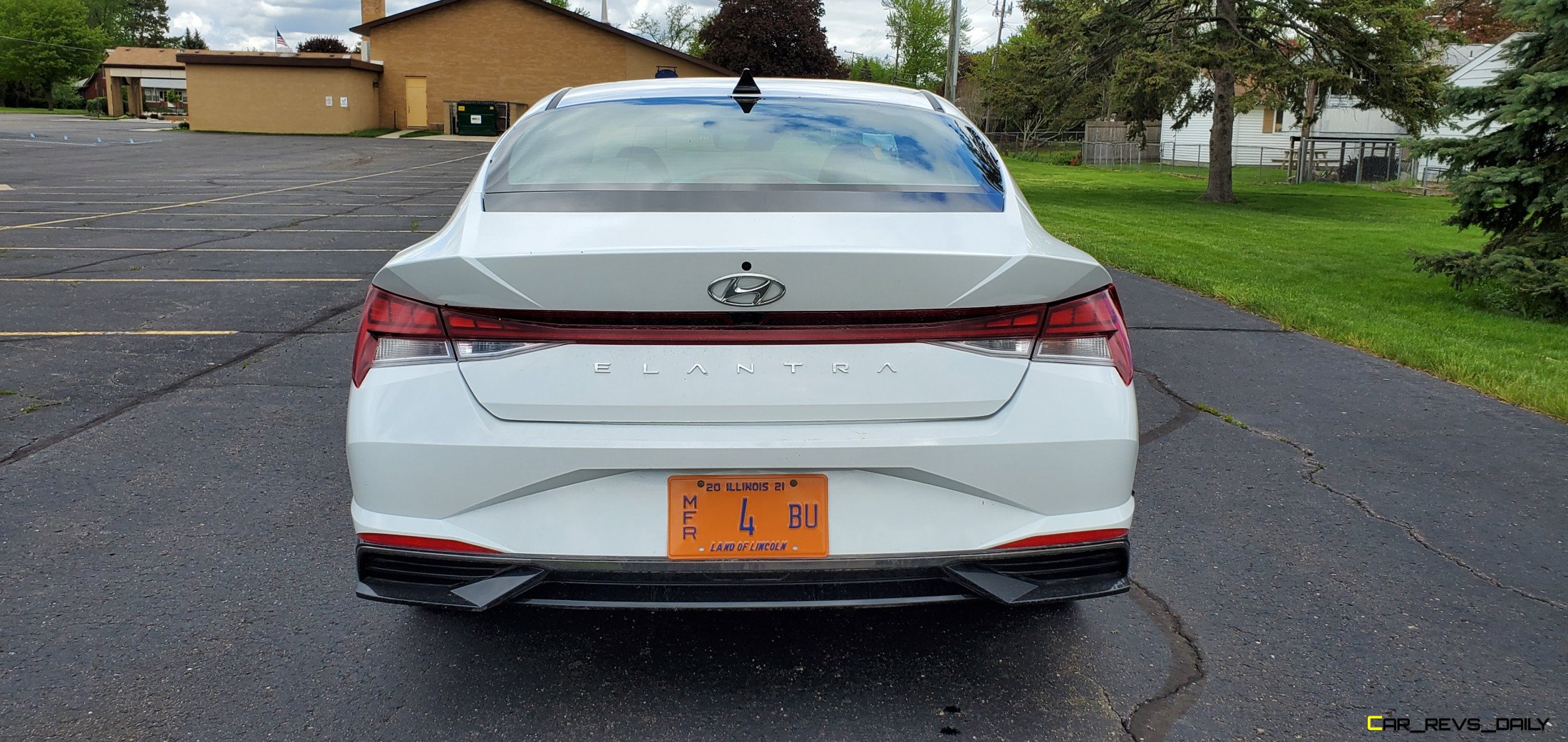Remember when Hyundai used to be known for making cars that blended into the environment and preferred to focus on rock bottom pricing? If you don’t, we don’t blame you with Hyundai successfully rehabbing its styling image over the past decade. What was once functional and Maytag chic has transformed into a daring design language that has helped Hyundai become a key player in the automotive segment. But while the Sonata and the Tuscon are currently commanding the bulk of the spotlight, Hyundai has not forgotten about the Elantra and has given the tiny four-door its own makeover for 2021. But is it good enough to stand out from utility offerings?
Digitally Crafted For The Younger Crowd

When Hyundai designers went to work crafting the 2021 Hyundai Elantra, they wanted to give the little four-door (the hatchback version was axed from our shores last year, and we still miss it) styling that would help it click with younger buyers. From some angles, it would seem that Hyundai designers simply took the Sonata’s design and shrink-wrapped it for the smaller Elantra. The front fascia has an all-new front grille that’s more athletic than before, with the swept-back headlights giving the Elantra a more aggressive look. Buyers looking for more spice can opt for the N-Line model, which adds some visual adornments and some subtle muscular tones to the design.
The side profile features several prominent design lines and some subtle creases. This isn’t your father’s compact, and the cool lines here do an excellent job of drawing stares and praise. The rear is where the Sonata vibes are the most prominent, with the taillights having the same vibes as their bigger counterparts. The rear styling here is slightly exaggerated, with the pinched trunk lid housing a lightbar that unifies the two taillight pieces. The rear bumper has more aggressive traits, and it leads down to the faux exhaust housings.
While the segment has shrunk over the past few years due to the rise of utility vehicles, the Elantra still has to face off against several rivals aiming to generate maximum attention. We think the Elantra has a leg up over the Toyota Corolla in this arena, but with the 2022 Honda Civic just making its way into dealerships now, the 2021 Elantra will have its work cut out in its attempts to make its voice heard in the minds of customers.
Elantra Interior Continues To Offer Top Dollar Value

While the exterior of the 2021 Elantra takes risks in making a styling statement, the interior prefers to take a more deliberate approach in its presentation. If you spent time in a Sonata or a Tuscon before, much of the scenery here will be familiar to you. The steering wheel, the digital instrument cluster, and the basic trim design follows its corporate stablemates to the letter. Still, with the Elantra fighting at a lower price point, some slight compromises reflect its segment. For example, there’s a slightly higher amount of cheap plastics, and even a phantom panel adorned with a plus symbol. Hyundai claims that in models like our tester, it’s supposed to balance out the dashboard, with N-Line models using the space for an additional digital gauge readout.
But look past some of these expected compromises, and you’ll discover that the interior is a very comfortable place with an impressive array of standard equipment. While Limited models come fully loaded, the real spotlight is on the base SE model, which aims to be a potent value player in the lineup. That model comes with a standard 8.0-inch infotainment system that comes with standard wireless Android Auto and Apple CarPlay capability. This is the first time that the technology has made its way into the compact segment, and on the surface, it appears to give the Elantra an edge. Opt for an SEL model like our tester, and you get a higher degree of standard equipment.
The SEL is also where buyers can opt for the $950 Convenience Package and the $2,100 Premium Package. Both of these optional add-ons greatly enhance the amount of equipment that the SEL brings to the table. That includes goodies such as a heated seat and steering wheel, a large 10.25 inch digital TFT instrument screen, LED lighting, and a premium Bose audio system. As a bonus, the premium package equips the Elantra with bigger 17-inch wheels, which allowed our tester to do a pretty good impression of the range-topping Limited.
Elantra Performance Focuses On Fuel Economy Over Performance
With Hyundai preferring to leave performance duties to the Elantra N-Line, it should come as no surprise that other Elantra variants like our SEL tester prefer to focus more on fuel economy than outright speed. Our tester arrived with a 2.0-liter four-cylinder engine that’s good for 147 hp and 132 lb-ft of torque. These numbers don’t promise much driving thrills, and our tester lived up to that with acceleration being on the sluggish side when we tasked the Elantra with spirited acceleration runs. However, if you drive the car as you would in typical city commuting, the Elantra has enough poise to go through the motions.
Ride quality is also smooth, and while the Elantra is far from being a luxury car, the suspension did a good job of soaking up many of the bumps and divots that dotted our driving route. Elantras, like our example, send power to the front wheels through Hyundai’s Intelligent Variable Transmission (IVT), which uses Smartstream technology to help enhance fuel economy. The transmission does a pretty good job impersonating a traditional automatic, but we noted instances where the IVT was a bit jittery on downshifts.
Braking in our tester was stable and consistent, with our tester having enough stopping power for many city driving situations. With the Elantra going toe to toe with the Toyota Corolla and the Honda Civic, the Elantra is still in a fascinating paradox in terms of performance. We think that it still has a leg up over the Corolla’s four-cylinder. Still, with the 2022 Honda Civic continuing to offer a 158 horsepower four-banger in the base and Sport trims, an SEL Elantra comes up a bit short in that particular department.
Value Quotient
Pricing for the 2021 Hyundai Elantra starts at $19,650, which covers a base SE model. SE variants feature a balanced mixture of standard equipment and serve as a very interesting gatekeeper for the range. SEL models like our tester are the logical step up and start at $20,900. These models have more equipment, and as mentioned, they also allow buyers to access the Elantra’s option packages. Our SEL tester had a final price of $25,110, mainly due to the Convenience and Premium packages.
The N-Line and the Limited models are the next two rungs up on the ladder and are also where the Elantra reaches its full potential both in performance and equipment. But with the SEL the subject of our focus, this time around, we might as well look at some of the rivals it faces. The Corolla XLE is slightly less expensive than the Elantra, but the interior does lack some of the Elantra’s advanced touches and equipment.
Meanwhile, the 2022 Honda Civic EX is also slightly less expensive than the Elantra before any packages are added. Still, this $24,700 flavor of Civic comes with a beefier 180 hp turbocharged four-cylinder and is only topped in performance by the much more expensive 201 horsepower Elantra N-Line.
While the 2021 Hyundai Elantra SEL might lack the muscle that defines some of its rivals, it prefers that you ignore that fact of life (as mentioned, that’s what the N-Line model is for.) Instead, the shapely Hyundai prefers you focus your attention on the sheer amount of content you can get for the dollar and the fuel economy numbers. If you’re a buyer who puts fuel economy and has the latest technology in the top categories of your priorities list, then the 2021 Elantra SEL will be the perfect balanced offering for your driveway.

Carl Malek has been an automotive journalist for over 10 years. First starting out as a freelance photographer before making the transition to writing during college, his work has appeared on numerous automotive forums as well as websites such as Autoshopper.com.
Carl is also a big fan of British vehicles with the bulk of his devotion going to the Morgan Motor Company as well as offerings from Lotus, MG, and Caterham. When he is not writing about automobiles, Carl enjoys spending time with his family and friends in the Metro Detroit area, as well as spending time with his adorable pets.




















